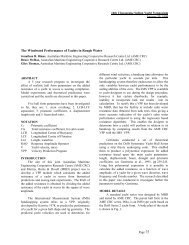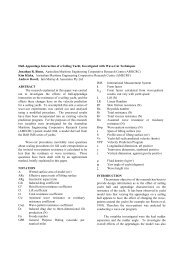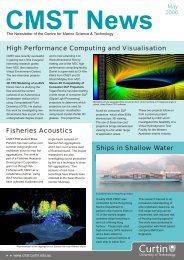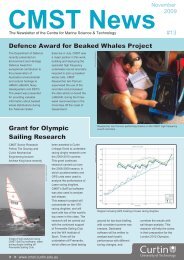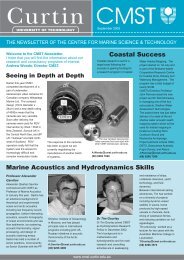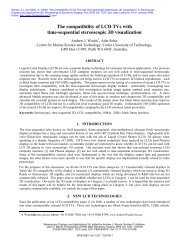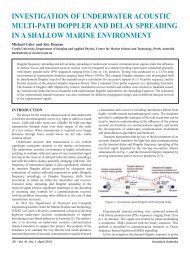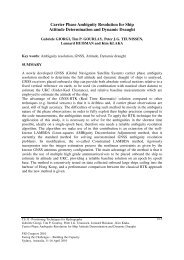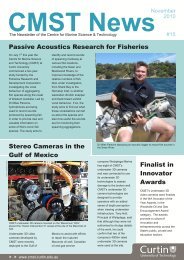Blue whale calling in the Rottnest trench-2000, Western ... - ANP
Blue whale calling in the Rottnest trench-2000, Western ... - ANP
Blue whale calling in the Rottnest trench-2000, Western ... - ANP
Create successful ePaper yourself
Turn your PDF publications into a flip-book with our unique Google optimized e-Paper software.
• a water column sound speed structure based on that shown <strong>in</strong> Figure 4-bottom (ie. a 200 &<br />
75 m thick Leeuw<strong>in</strong> current) and extrapolated to that shown on Figure 5, and <strong>in</strong>put <strong>in</strong>to RAM<br />
at 25 m depth steps;<br />
• <strong>the</strong> seafloor parameters listed <strong>in</strong> Table 2 with <strong>the</strong> medium sand layer thickness constant at 0.5<br />
m for water depths ≤ 200 m <strong>the</strong>n l<strong>in</strong>early <strong>in</strong>creased to 50 m thick at 2500 m water depth;<br />
• <strong>the</strong> eight bathymetry paths shown <strong>in</strong> Figure 17, with <strong>the</strong> bathymetry calculated at a 250 m<br />
<strong>in</strong>terval and <strong>in</strong>put <strong>in</strong>to RAM <strong>in</strong> 500 m steps;<br />
• <strong>the</strong> transmission loss calculated <strong>in</strong> 100 m steps out to 37-50 km (depend<strong>in</strong>g on which head<strong>in</strong>g<br />
was used);<br />
• us<strong>in</strong>g <strong>the</strong> pr<strong>in</strong>ciple of reciprocity, <strong>the</strong> RAM receiver placed at <strong>the</strong> actual source depth of 20 or<br />
40 m, and a RAM source placed at <strong>the</strong> actual receiver depth of 475 m (<strong>the</strong> bathymetry<br />
program <strong>in</strong>terpolated depth at <strong>the</strong> bluey logger site)<br />
• a frequency of 24 Hz.<br />
The output of RAM gave transmission loss (dB) with range, at <strong>the</strong> specified frequency, for a<br />
fixed receiver depth equivalent to <strong>the</strong> bluey logger location, a source depth of 20 or 40 m and for<br />
eight profiles on 45 o head<strong>in</strong>gs from <strong>the</strong> logger location. To <strong>the</strong>n convert <strong>the</strong> transmission loss<br />
estimates to a blue <strong>whale</strong> component received level at a specified range, required an estimate of<br />
<strong>the</strong> appropriate component source level. This is dealt with below.<br />
3.3) <strong>Blue</strong> <strong>whale</strong> source levels<br />
Three estimates of <strong>the</strong> source level (<strong>the</strong>oretical level of <strong>the</strong> noise source assum<strong>in</strong>g it to be a po<strong>in</strong>t<br />
and <strong>the</strong> measure made at 1 m range from <strong>the</strong> po<strong>in</strong>t) of blue <strong>whale</strong> calls are given <strong>in</strong> <strong>the</strong> literature.<br />
Cumm<strong>in</strong>gs and Thompson (1971) present an estimate of an average source level <strong>in</strong> <strong>the</strong> 14-222<br />
Hz band (or encompass<strong>in</strong>g all <strong>the</strong> signal energy) as 188 dB re 1μPa at 1 m, for blue <strong>whale</strong>s<br />
recorded off <strong>the</strong> Chilean coast. They do not state <strong>the</strong> type of measurement so it is assumed to be<br />
<strong>the</strong> mean squared pressure or squared rms value of <strong>the</strong> signal, s<strong>in</strong>ce this is <strong>the</strong> most common<br />
measurement type reported. In terms of absolute pressure this is ma<strong>the</strong>matically equivalent to:<br />
p<br />
2<br />
1<br />
=<br />
T<br />
Te<br />
2<br />
∫ ps+<br />
n<br />
T0<br />
( t)<br />
dt<br />
where:<br />
2<br />
p = <strong>the</strong> mean squared pressure or <strong>the</strong> square of <strong>the</strong> rms pressure, reduced to an equivalent<br />
value at 1 m range from <strong>the</strong> source<br />
T = <strong>the</strong> signal duration<br />
ps+n = <strong>the</strong> blue <strong>whale</strong> pressure signal plus <strong>the</strong> noise<br />
In all calculations carried out <strong>in</strong> this analysis <strong>the</strong> mean squared pressure was calculated by us<strong>in</strong>g<br />
<strong>the</strong> portion of <strong>the</strong> signal which encompassed 95% of <strong>the</strong> signal energy (thus standardis<strong>in</strong>g <strong>the</strong><br />
way T was calculated) and by subtract<strong>in</strong>g <strong>the</strong> background noise component from <strong>the</strong> signal of<br />
<strong>in</strong>terest (ie replac<strong>in</strong>g<br />
p + above with<br />
2<br />
s n<br />
p ).<br />
2<br />
s<br />
Cumm<strong>in</strong>gs and Thompson (1971) estimated <strong>the</strong> source level us<strong>in</strong>g spherical spread<strong>in</strong>g and visual<br />
estimates of range from <strong>call<strong>in</strong>g</strong> <strong>whale</strong>s.<br />
D'Spa<strong>in</strong> et al (1995) used complex localisation techniques from record<strong>in</strong>gs made with vertical<br />
arrays of hydrophones to estimate <strong>the</strong> 3D location of <strong>call<strong>in</strong>g</strong> blue <strong>whale</strong>s off <strong>the</strong> Californian<br />
22



